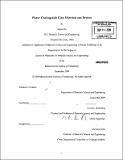| dc.contributor.advisor | Lionel C. Kimerling. | en_US |
| dc.contributor.author | Hu, Juejun | en_US |
| dc.contributor.other | Massachusetts Institute of Technology. Dept. of Materials Science and Engineering. | en_US |
| dc.date.accessioned | 2010-04-28T17:01:58Z | |
| dc.date.available | 2010-04-28T17:01:58Z | |
| dc.date.copyright | 2009 | en_US |
| dc.date.issued | 2009 | en_US |
| dc.identifier.uri | http://hdl.handle.net/1721.1/54562 | |
| dc.description | Thesis (Ph. D.)--Massachusetts Institute of Technology, Dept. of Materials Science and Engineering, 2009. | en_US |
| dc.description | Cataloged from PDF version of thesis. | en_US |
| dc.description | Includes bibliographical references (p. 199-213). | en_US |
| dc.description.abstract | The intrinsic advantages of small footprint, low fabrication cost and immunity to electromagnetic interference make planar photonic device technologies a promising solution to a number of key technical challenges. The examples include high-speed telecommunication, on-chip optical interconnect, imaging and photovoltaics. Another important area planar photonic technologies may penetrate into is biochemical sensing. High precision optical metrology tools can be applied to detect optical property changes associated with the presence of biological or chemical molecules, leading to sensitive, rapid detection of these molecular species. In this thesis, we focus on the development of novel photonic materials and devices that address the emerging need in the field of biochemical sensing. Chalcogenide glasses have been identified as the material of choice for sensing due to their wide infrared transparency window; on the device side, we have fabricated optical resonator devices that dramatically amplify the photon-molecule interactions towards highly sensitive detection. We have developed and optimized a lift-off patterning technique for Si-CMOS backend compatible fabrication of high-index-contrast (HIC) chalcogenide glass devices. A thermal reflow technique further removes the sidewall roughness resulting from the patterning process and is shown to effectively reduce the scattering loss in chalcogenide glass waveguides. Using the lift-off technology, we have demonstrated the first microring and micro-disk resonators in chalcogenide glasses, with a record loaded cavity quality factor (Q-factor) exceeding 2 x 105. | en_US |
| dc.description.abstract | (cont.) We have shown that these high-Q chalcogenide glass resonators can serve as highly sensitive refractometry sensors with a refractive index detection limit down to 8 x 107. This high sensitivity agrees with our theoretical analysis, which predicts one to two orders of magnitude performance improvement over surface plasmonic resonance (SPR) sensors. The optofluidic resonator devices are leveraged to detect surface binding of biological molecules. Label-free detection of proteins at clinically relevant concentrations (< 1 ng/mL) has been experimentally verified. We have also demonstrated cavity enhanced absorption spectroscopy near the 1500 nm infrared wavelength. By taking advantage of the strong optical resonance enhancement, we achieved 3-fold chemical sensing sensitivity improvement and 40-fold device physical size reduction simultaneously compared to evanescent waveguide sensors, which clearly demonstrates the competitive advantage of using resonators for cavity enhanced infrared absorption spectroscopy. Lastly, we have developed a novel precision metrology technique, resonant cavity refractometry, for glass property investigation. It leverages the extreme sensitivity of optical resonators to optical property change of their constituent materials, to accurate extract property and micro-structural evolution information of glass materials. We apply this technique to characterize photosensitive index change and two photon absorption in chalcogenide glasses with very high accuracy. | en_US |
| dc.description.abstract | (cont.) We also report the first experimental observation of cavity enhanced photosensitivity of As2S3 glass to 1550 nm telecommunication wavelength light, an important design consideration for nonlinear optical devices using chalcogenide glasses*. | en_US |
| dc.description.statementofresponsibility | by Juejun Hu. | en_US |
| dc.format.extent | 213 p. | en_US |
| dc.language.iso | eng | en_US |
| dc.publisher | Massachusetts Institute of Technology | en_US |
| dc.rights | M.I.T. theses are protected by
copyright. They may be viewed from this source for any purpose, but
reproduction or distribution in any format is prohibited without written
permission. See provided URL for inquiries about permission. | en_US |
| dc.rights.uri | http://dspace.mit.edu/handle/1721.1/7582 | en_US |
| dc.subject | Materials Science and Engineering. | en_US |
| dc.title | Planar chalcogenide glass materials and devices | en_US |
| dc.type | Thesis | en_US |
| dc.description.degree | Ph.D. | en_US |
| dc.contributor.department | Massachusetts Institute of Technology. Department of Materials Science and Engineering | |
| dc.identifier.oclc | 567643223 | en_US |
